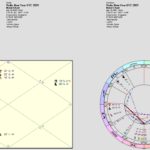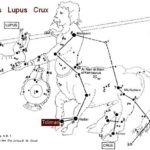One of the many New Year charts used in Vedic astrology is based on the New Moon in Pisces, when the Sun and Moon conjoin in the same celestial longitude (conjunction) in the Pisces constellation. This is known as the culmination of the New Moon in the pratipada tithi. (Please note that I am a sidereal astrologer and use the sidereal zodiac exclusively). The New Moon in Pisces is called Chaitra Shukla Pratipada, the first synodic lunar day (tithi) of the waxing Moon (shukla paksha) in the Vedic month of Chaitra.
References in the Brahma Purana and the Chaturvarga Chintamani of Hemadri state that Lord Brahma created the universe on Chaitra Shukla Pratipada. So simply, every year we celebrate the beginning of the Vedic Lunar New Year at the same astrological point that Lord Brahma created the universe! In this current year of 2021, the New Moon culminates in the Chaitra Shukla Pratipada tithi on April 11, 2021 in the U.S. capital of Washington D.C., at 10:30:41 PM Eastern Daylight Time, and on April 12 at 2:30:41 AM UTC. In India, it will occur on April 12 at 08:00:41 AM.
(Here are the astrological New Year charts for the UTC time zone, the U.S., and India. I discuss the charts for the UTC time zone and the US. further on).


 The horoscope for the Vedic New Year is calculated for the place, date, and time of the New Moon. Each country will have its own New Year chart based on its unique coordinates and time zones. The planets will be in the same signs but will move into other houses in the various country charts, and the new year karma of the different countries will be revealed in the various charts. The Vedic New Year begins on the day when the pratipada tithi is in place by sunrise. For North and South America and Europe, the New Year begins on April 12. For India and the rest of Asia, Australia, New Zealand and points east, it begins on April 13.
The horoscope for the Vedic New Year is calculated for the place, date, and time of the New Moon. Each country will have its own New Year chart based on its unique coordinates and time zones. The planets will be in the same signs but will move into other houses in the various country charts, and the new year karma of the different countries will be revealed in the various charts. The Vedic New Year begins on the day when the pratipada tithi is in place by sunrise. For North and South America and Europe, the New Year begins on April 12. For India and the rest of Asia, Australia, New Zealand and points east, it begins on April 13.
The beginning of the Vedic New Year also marks the start of Vasant or Chaitra Navratri, the nine-night spring festival of Mother Divine, when Devi Durga comes down to bless and cleanse the world and all her children at the beginning of the Lunar New Year. It is a very auspicious period and time of positive growth and transformation for Her devotees. Navratri and the Vedic New Year celebrations begin on April 12 in North and South America and Europe, and in India and everywhere else in the world on April 13. This is based on the astrological principle that the night of Navratri begins on the day when the pratipada tithi (culmination of the New Moon) is in place by sunrise.
The samvatsara for this New Year is called Plava. A samvatsara is a Sanskrit term for “year.” In the Vedic system, there are 60 samvatsaras. They are described in Brihat Samhita by Sage Varahamahira in “Chapter VIII: Jupiter’s Course (Jovian years).” Each samvatsara carries a particular essence that correlates with its Sanskrit name and also is related to its group ruler.
The samvatsara for 2021-2022 is the fourth in a group of five years ruled by the Manes, who are of two kinds: they are the children of Lord Brahma, known as the Prajapatis, who are great rishis, progenitors, and protectors of the earth, the animal kingdom, and the human race. The Manes are also known as the “Ancestors.” They inhabit their own region between the realms of humans and gods, a place known as Pitriloka. The current five-year cycle ruled by the Manes extends from 2017 to 2022 and is considered to be a challenging period of much calamity. I feel that ancestral propitiation and healing are extremely important during this period as it is ruled by the Ancestors.
The Jyotish shastra says that those born in the Plava year may be wealthy, compassionate, courageous, compassionate, devoted to their duties (karma yoga), but often very restless. Some sources have described the Plava year as a time of prosperity, and for awakening of humanitarianism, wisdom, and knowledge, which makes sense as Plava is defined as “excellent, superior, and leaping or jumping.” It also means floods, swimming, and a boat or raft, and the Plava year is said to bring copious rains to many regions of the world.
Plava is also considered to be a year when we quickly start to move away from the difficulties of the past Sarvari year which was a year of darkness, but we will also leap into many new kinds of experiences that are perhaps equally challenging. By the end of this year, we will also be making another leap into a brand new cycle after the very difficult past five-year cycle of the Manes.
The last Plava year was in 1961 during the Cold War between Russia and the U.S., when there were also many riots in the U.S. during the Civil Rights movement; JFK was President, and the Vietnam War officially began; the space race was intensifying, and Russian cosmonaut Yuri Gagarin became the first person to ever cross into outer space. The Russians also detonated the largest ever thermonuclear bomb, a 50-megatron device, in the archipelago of Novaya Zemlya.
The previous Plava year was in 1901 during the Chinese drought and famine that killed 45 million people from 1959-1961. This year saw the worst heat wave on record in the U.S. (east coast), which killed 9500 people. It was also the year of the first modern medical disaster in which a group of children in St. Louis were tragically contaminated and killed by an antitoxin medicine (Tetanus-Diphtheria/St. Louis Incident). So Plava years are often years when we will see many “firsts,” as in events that have never happened before.
The New Year chart I use for the world at large is set for the UTC time zone in Greenwich. Here, the Midheaven (MC/Madhya Lagna) conjoins the fixed star Toliman (or Bungala), also called Alpha Centauri, the brightest star in Centaurus constellation (but it’s not the same centaur as Sagittarius). Toliman is the third brightest star in the night sky, and the closest star to our solar system. It is situated on the left front hoof of the Centaur at 5 degrees 35 minutes of sidereal Scorpio. When this star is prominent, it signifies enthusiasm and the capacity to sacrifice for a cause…a bountiful flow of energies from within, or Above, however we may express it.” (Ted George, The Fixed Stars, Health and Behavior Imbalances)  (As a point of note, Alpha Centauri is actually two binary stars that are quite similar to our Sun. A third star that’s gravitationally bound to them is Proxima Centauri, which is technically the closest star to our Sun. Recently, alien hunters have discovered a transmission from what may be some form of advanced extraterrestrial intelligence (ETI)—a so-called “technosignature” from the direction of Proxima Centauri. I wonder if the fact that this star system culminates in the New Year chart means that there will be a further discovery about this).
(As a point of note, Alpha Centauri is actually two binary stars that are quite similar to our Sun. A third star that’s gravitationally bound to them is Proxima Centauri, which is technically the closest star to our Sun. Recently, alien hunters have discovered a transmission from what may be some form of advanced extraterrestrial intelligence (ETI)—a so-called “technosignature” from the direction of Proxima Centauri. I wonder if the fact that this star system culminates in the New Year chart means that there will be a further discovery about this).

By Skatebiker at English Wikipedia, CC BY-SA 3.0, https://commons.wikimedia.org/w/index.php?curid=46833562
The two bright stars in the above image are (left) Alpha Centauri and (right) Beta Centauri, both binaries. The faint red star in the center of the red circle, at right angles to both and south-east of Alpha is Proxima Centauri, intensely red, smaller in size, weaker in brightness and a distant third element in a triple star system with the main close pair forming Alpha Centauri.
This year, no matter which locale we are casting a New Year chart for, the New Moon falls at the 28th degree of Pisces, which is called the nakshatra gandanta, the sensitive edge between a water sign and fire sign, which suggests more turmoil and transformation. On the mundane level, it can represent floods and water accidents which are also indicated by the Plava year.
In the Greenwich chart for the UTC time zone, which I mentioned before that I use to get a sense of what’s happening globally as well as in the U.K., the ascendant is conjoined Pluto in Capricorn, which reflects a world in massive flux, in which many old structures and systems are breaking down. The Moon is the Lord of the Year because it rules the day of Monday, which is the day occurring on the Vedic New Year in that particular locale. The Moon being the Lord of the Year is said to bring abundant rains.
Because Saturn and Ketu are malefically aspecting the Moon, and as the Moon falls in the third house of the chart with the Sun and a debilitated Mercury, it suggests ongoing travel disruptions this year, worries about health matters, conflict between nations, and fear and discontentment among the masses.
In the U.S. chart, the Moon is also the Year Lord and occurs in the fifth house of the chart, also malefically aspected by Ketu from the first house and Saturn from the third. This suggests that crime is on the rise, and especially related to the southern borders being opened by the new administration, and also as to the ill treatment of women and children which I sense is going to be brought more to light. For instance, this may be related to human trafficking (made worse due to the border crisis), and also to the rampant abuse of children that is occurring as a result of the draconian government lockdowns of society, industry, and educational institutions.
The Year Lord under affliction in the fifth house also points to the potential for foreign terrorism which is a significant concern due to the border crisis. As the fifth house is eighth from the tenth, the afflicted lunation in the fifth house also suggests danger to the ruler of the nation and the nation as a whole. The fifth house lunation being afflicted also points to all levels of the educational system in major crisis due to lockdown disruptions along with many deeper systemic problems. The film and entertainment industries as well as certain medical, scientific, and government agencies may face major crises and setbacks also, due to corruption, losses, and scandals.
Many among the masses may continue to live in fear of dis-ease (as represented by the Moon under affliction from Saturn from the third house). Saturn in the third house aspecting Mercury, Sun, and Moon also suggests that even though travel within the U.S. is opening up in many areas, there is continued threat of federal, local, and state governments as well as private enterprises which will continue to interfere with and constrain freedom of choice and movement.
The U.S. New Year chart MC is conjoined two fixed stars, Thuban and Zosma. As they are crowning the chart, they do seem to represent a significant influence over events to come, and more specifically perhaps related to the government which is also indicated by the MC in mundane astrology.
Thuban or Alpha Draconis is a 3.6 magnitude pale yellow star in the tail of the Dragon in the Draco Constellation. It is visually an unremarkable star but is well known as it was the north pole star in ancient times. “Thuban” comes from the Arabic for “large snake.” It is sometimes associated with criminality (especially theft), accidental poisoning, pollution of air and water, or some problem or conflict related to mineral resources. Thuban is associated with the 13th Tarot Trump card “Death,” which usually signifies profound changes. Zosma, or Delta Leonis, is also culminating in the U.S. New Year chart. It is a pale triple star on the back of Leo the Lion. It can suggest an epidemic of depression as well as fear about disease or poisoning, all of which are prevalent at this time in the collective consciousness. Zosma here also auguries the sickness or death of an authority figure.
Zosma, or Delta Leonis, is also culminating in the U.S. New Year chart. It is a pale triple star on the back of Leo the Lion. It can suggest an epidemic of depression as well as fear about disease or poisoning, all of which are prevalent at this time in the collective consciousness. Zosma here also auguries the sickness or death of an authority figure.
 On a more positive note, the ancient Kabalists associated Leo (which contains Zosma at the core) with the 11th Tarot Trump card “Strength,” which represents the power, resilience, and capacity to overcome problems.
On a more positive note, the ancient Kabalists associated Leo (which contains Zosma at the core) with the 11th Tarot Trump card “Strength,” which represents the power, resilience, and capacity to overcome problems. May the winds, the oceans, the herbs, and night and days, the mother earth, the father heaven, all vegetation, the sun, be all sweet to us…Let us follow the path of goodness for all times, like the sun and the moon moving eternally in the sky…Let us be charitable to one another…Let us not kill or be violent with one another…Let us know and appreciate the points of view of others…And let us unite.
May the winds, the oceans, the herbs, and night and days, the mother earth, the father heaven, all vegetation, the sun, be all sweet to us…Let us follow the path of goodness for all times, like the sun and the moon moving eternally in the sky…Let us be charitable to one another…Let us not kill or be violent with one another…Let us know and appreciate the points of view of others…And let us unite.

